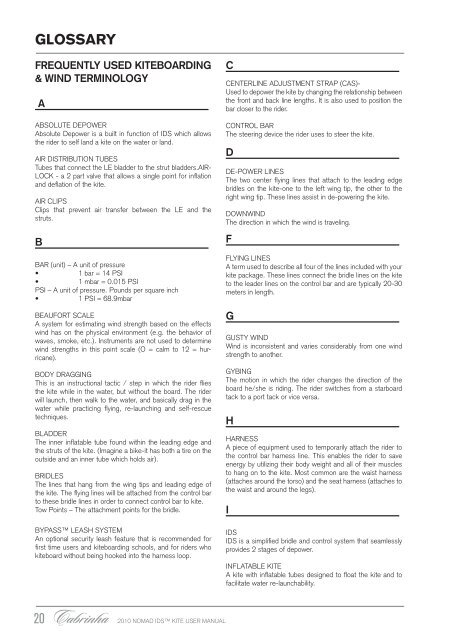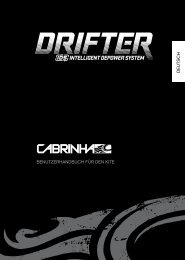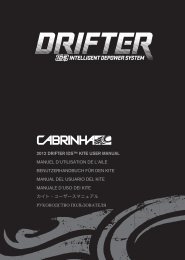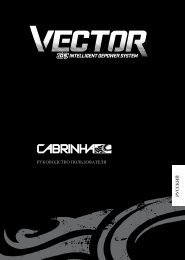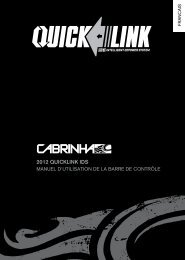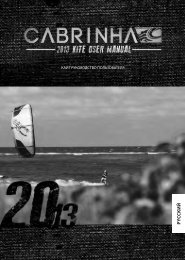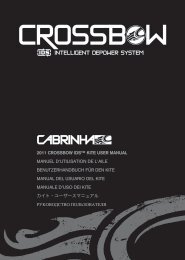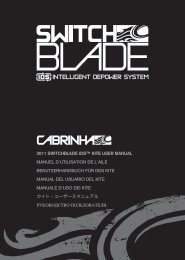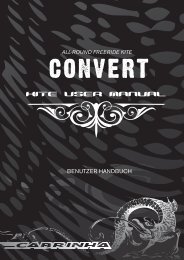2010 nomad ids⢠kite user manual manuel d'utilisation ... - Cabrinha
2010 nomad ids⢠kite user manual manuel d'utilisation ... - Cabrinha
2010 nomad ids⢠kite user manual manuel d'utilisation ... - Cabrinha
Create successful ePaper yourself
Turn your PDF publications into a flip-book with our unique Google optimized e-Paper software.
glossary<br />
FREQUENTLY USED KITEBOARDING<br />
& WIND TERMINOLOGY<br />
A<br />
Absolute Depower<br />
Absolute Depower is a built in function of IDS which allows<br />
the rider to self land a <strong>kite</strong> on the water or land.<br />
AIR DISTRIBUTION TUBES<br />
Tubes that connect the LE bladder to the strut bladders.AIR-<br />
LOCK - a 2 part valve that allows a single point for inflation<br />
and deflation of the <strong>kite</strong>.<br />
AIR CLIPS<br />
Clips that prevent air transfer between the LE and the<br />
struts.<br />
B<br />
BAR (unit) – A unit of pressure<br />
• 1 bar = 14 PSI<br />
• 1 mbar = 0.015 PSI<br />
PSI – A unit of pressure. Pounds per square inch<br />
• 1 PSI = 68.9mbar<br />
BEAUFORT SCALE<br />
A system for estimating wind strength based on the effects<br />
wind has on the physical environment (e.g. the behavior of<br />
waves, smoke, etc.). Instruments are not used to determine<br />
wind strengths in this point scale (O = calm to 12 = hurricane).<br />
BODY DRAGGING<br />
This is an instructional tactic / step in which the rider flies<br />
the <strong>kite</strong> while in the water, but without the board. The rider<br />
will launch, then walk to the water, and basically drag in the<br />
water while practicing flying, re-launching and self-rescue<br />
techniques.<br />
BLADDER<br />
The inner inflatable tube found within the leading edge and<br />
the struts of the <strong>kite</strong>. (Imagine a bike-it has both a tire on the<br />
outside and an inner tube which holds air).<br />
BRIDLES<br />
The lines that hang from the wing tips and leading edge of<br />
the <strong>kite</strong>. The flying lines will be attached from the control bar<br />
to these bridle lines in order to connect control bar to <strong>kite</strong>.<br />
Tow Points – The attachment points for the bridle.<br />
BYPASS LEASH SYSTEM<br />
An optional security leash feature that is recommended for<br />
first time <strong>user</strong>s and <strong>kite</strong>boarding schools, and for riders who<br />
<strong>kite</strong>board without being hooked into the harness loop.<br />
C<br />
CENTERLINE ADJUSTMENT STRAP (CAS)-<br />
Used to depower the <strong>kite</strong> by changing the relationship between<br />
the front and back line lengths. It is also used to position the<br />
bar closer to the rider.<br />
CONTROL BAR<br />
The steering device the rider uses to steer the <strong>kite</strong>.<br />
D<br />
DE-POWER LINES<br />
The two center flying lines that attach to the leading edge<br />
bridles on the <strong>kite</strong>-one to the left wing tip, the other to the<br />
right wing tip. These lines assist in de-powering the <strong>kite</strong>.<br />
DOWNWIND<br />
The direction in which the wind is traveling.<br />
F<br />
FLYING LINES<br />
A term used to describe all four of the lines included with your<br />
<strong>kite</strong> package. These lines connect the bridle lines on the <strong>kite</strong><br />
to the leader lines on the control bar and are typically 20-30<br />
meters in length.<br />
G<br />
GUSTY WIND<br />
Wind is inconsistent and varies considerably from one wind<br />
strength to another.<br />
GYBING<br />
The motion in which the rider changes the direction of the<br />
board he/she is riding. The rider switches from a starboard<br />
tack to a port tack or vice versa.<br />
H<br />
HARNESS<br />
A piece of equipment used to temporarily attach the rider to<br />
the control bar harness line. This enables the rider to save<br />
energy by utilizing their body weight and all of their muscles<br />
to hang on to the <strong>kite</strong>. Most common are the waist harness<br />
(attaches around the torso) and the seat harness (attaches to<br />
the waist and around the legs).<br />
I<br />
IDS<br />
IDS is a simplified bridle and control system that seamlessly<br />
provides 2 stages of depower.<br />
INFLATABLE KITE<br />
A <strong>kite</strong> with inflatable tubes designed to float the <strong>kite</strong> and to<br />
facilitate water re-launchability.<br />
20 <strong>2010</strong> Nomad IDS KITE USER MANUAL


